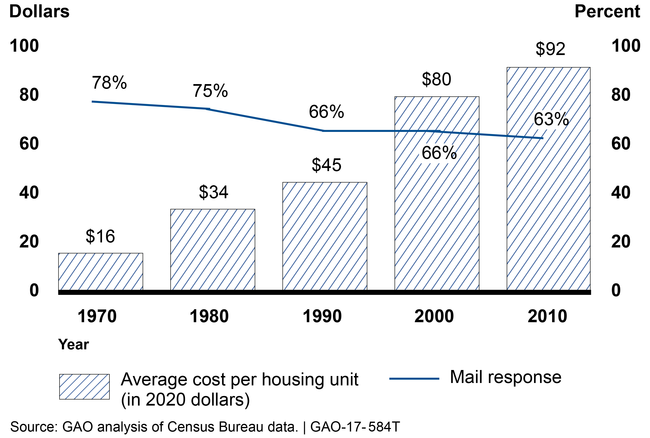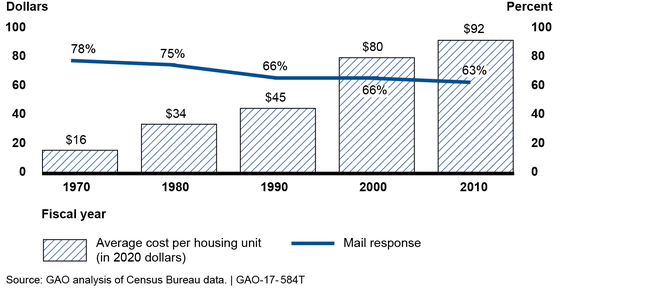2020 Census: Sustained Attention to Innovations, IT Systems, and Cost Estimation Is Needed
Fast Facts
The 2010 Census was the costliest in the nation's history—roughly $12.3 billion.
The U.S. Census Bureau is planning innovations for the 2020 Census which may lower costs, including re-engineering field operations and allowing the public to respond using the Internet. While these innovations show promise for controlling costs, their novelty also introduces new risks.
In today's testimony we discuss the Bureau's need to fully test these new procedures, as well as the need to address challenges related to IT programs and systems supporting the 2020 Census. We also found the Bureau's cost estimate for the upcoming census to be unreliable.
Average Cost of Counting Each Housing Unit Rose While Mail Response Rates Declined

Bar graph with increasing cost per housing unit and a line graph with decreasing mail response rates
Highlights
What GAO Found
The U.S. Census Bureau (Bureau) is planning many innovations for the 2020 Census, including re-engineering field operations, using administrative records to supplement census data, verifying addresses in-office using on screen imagery, and allowing the public to respond using the Internet. These innovations show promise for controlling costs, but they also introduce new risks, in part because they include new procedures and technologies that have not been used extensively in earlier decennials, if at all. It will be important for the Bureau to fully test these activities under census-like conditions during the 2018 End-to-End Test scheduled to begin August 2017 and make appropriate modifications.
Average Cost of Counting Each Housing Unit Rose While Mail Response Rates Declined

The Bureau continues to face challenges in managing and overseeing the information technology (IT) programs, systems, and contracts supporting the decennial census. These challenges include managing internal coordination and governance, contracts, schedule, scope, and IT costs. For example, GAO expects that the IT costs will rise due to increases in the scope of work for the integration contract. In addition, the Bureau needs to address several security risks and challenges to secure its systems and data, including ensuring that security assessments are completed in a timely manner. Given that the 2018 End-to-End test begins in August 2017, it will be important that the agency work to address these challenges quickly. GAO has ongoing work that is reviewing each of these challenges.
The Bureau's October 2015 cost estimate for the 2020 Census does not fully reflect characteristics of a high-quality estimate and cannot be considered reliable. Overall, GAO found that the cost estimate partially met the characteristics of two best practices (comprehensive and accurate) and minimally met the other two (well-documented and credible). Additionally, the Bureau has not published an update to its October 2015 cost estimate, yet several events since then including changes to the census design suggest that the cost of the current design (around $12.5 billion in 2020 constant dollars) could be higher than planned.
Why GAO Did This Study
One of the most important functions of the Bureau is conducting a complete and accurate decennial census of the U.S. population, which is mandated by the Constitution and provides vital data for the nation. A complete count of the nation's population is an enormous challenge as the Bureau seeks to control the cost of the census, implement operational innovations, and use new and modified IT systems. In recent years, GAO has identified challenges that raise serious concerns about the Bureau's ability to conduct a cost-effective enumeration. For these reasons, GAO added the 2020 Census to the High-Risk List in February 2017.
In this statement, GAO discusses three challenges: (1) implementing new innovations, (2) implementing and securing critical IT systems (3) and ensuring the reliability of the Bureau's cost estimate for the 2020 Census.
The information in this testimony is based primarily on GAO's previous reports on the Bureau's planning efforts for 2020. GAO also collected and reviewed new information on the following Bureau activities: (1) recent decisions on preparations for the 2020 Census, (2) IT security testing leading up to the 2017 Census Test, (3) progress on key systems to be used for the 2018 Census Test, and (4) efforts to update its life-cycle cost estimate.
Recommendations
GAO has previously made a number of recommendations to address issues raised in this testimony, many of which have not yet been implemented.
